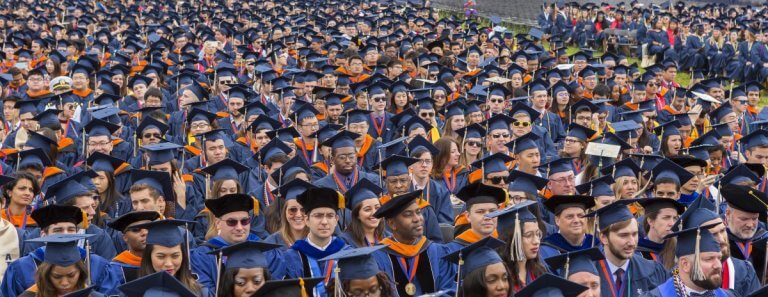
The US has long been destination of choice among prospective global learners. Year after year, non-native students flock to the Land of Opportunity, unable to resist the promise of an elite education with a hot, steamy slice of the American dream.
This is the country where futures are forged and destined to flourish; a nation enriched by the intricate merging of cultures; where any average Joe who’s willing to graft can be the next billionaire CEO.
But Trump’s 2016 election was an event that shook the world, and many feel his ongoing war on inbound students could easily signal the end of a golden education era. He represents just one in a tempestuous tide of world leaders – including Turkey’s Recep Tayyip Erdoğan, Hungary’s Viktor Orbán and Brazil’s Jair Bolsonaro – to have gained relentless power fuelled by a belief that’s inherently anti-immigrant.
From stringent visa reviews to dwindling work rights, and even a website alteration sneak attack seeking to block foreign student access to US jobs, Trump’s laborious efforts to turn foreign talent off has seen specialist visa applications drop by one-fifth.
But by no means does this story begin and end with Trump. It’s an issue that runs deeper, with media platforms questioning the state of US higher education long before he entered the White House, and no doubt continuing long after he’s gone.

Trump may not be the greatest advocate for US higher education, but is the overall picture of the sector really as grim as it seems? Source: Shutterstock
Students and academics alike lament the industry’s status as a corporate conveyor belt; a money-grabbing system in which applicants are seen as little more than ‘cash cows’ before sending them into the world with debilitating debt. Since 2012, US students have suffered total fee hikes of almost $5,000 – that’s more than 1k per year.
As The Atlantic so eloquently explains, the “outrageous price of a US degree is unique in the world”.
Headlines speak of ‘Trump’s Brain Drain’, ‘The Broken Promise of Higher Education’ and ‘The Pillaging of America’s State Universities’. If these words are anything to go by, you’d be forgiven for thinking that things aren’t looking so good for education in old Uncle Sam.
But the Open Doors Report launched in November 2018 paints an entirely different picture; one in which, according to statistics, US universities have managed to avoid the controversial ripples of the ‘Trump Effect’.
The report on International Education Exchange shows that the number of international students in the US surpassed one million for the third consecutive year, growing by 1.5 percent to reach a record high of 1,094,792.
The common thread in the H-1B tech brain drain from the U.S. to Canada “reporting” is that Canada stands to gain “talent” however the argument about abuse of the program is at lower end of the scale so it’s not clear that Canada will benefit at higher end. https://t.co/vM7DlxjrY6
— Mark Warner (@MAAWLAW) 12 January 2019
Unlike the UK, a country set to lose its status as the world’s 2nd-most popular study destination any day now (if it hasn’t already), America has maintained its position as the most favoured study hotspot on the globe. In 2017, the country earned a staggering $42.4 billion through fees for tuition, room and board from non-native students. It seems that students’ apparent disillusion with US universities has not yet been reflected in their willingness to pay fees.
The view that as fees go up, demand for US education goes down makes perfect sense – but that doesn’t make it true. Historically, undergraduate enrolments have remained steady, regardless of whether the country’s economy revelled in prosperity or suffered adversity at that time.
In fact, more than 20 million students are enrolled in higher education institutions across the US – a national cohort almost 100 times larger than the student population of 1900, and nearly 10 times larger than that of 1950, considerably outpacing the rate of population growth in America.
Add to this the current impact and potential magnitude of online degrees. According to a report by the Babson Survey Research Group, based on federal data from more than 4,700 colleges and universities, more than 6.3 million students in the US, most of whom were undergraduate, took at least one online course in fall 2016 – a 5.3 percent increase on the previous year.

More and more students are choosing to pursue a US degree online. Source: Shutterstock
Enrolment in online courses rose at a faster pace between fall 2015 and 2016 compared to the previous three years. This matters because digital offerings allow universities to attract and retain new demographics on all corners of the globe. Students who could never have dreamed of earning a world-class US degree can now do so from the comfort of their homes for a much more affordable price. More international enrolments and a greater global footprint is a win for HE providers, regardless of its streamlined price.
The digital learning realm is already huge, and when higher education heavyweights like Harvard Business School step firmly behind the trend, you know it’s not likely to slow any time soon.
Oregon State University has jumped to be among the nation’s top three leaders in online education, according to rankings released today by U.S. News & World Report. https://t.co/6B40VBuZCI
— KTVZ NewsChannel 21 (@KTVZ) 15 January 2019
Then there’s the matter of research. According to a report published in the scientific journal Minerva in 2017, research expenditures at major American research universities grew by more than 10 times in inflation-adjusted dollars between 1980 and 2010. On top of this, high-calibre publications recorded in the Web of Science almost tripled throughout the same period.
Eager to fuel the expanding knowledge economy – a social dimension to which universities are fundamental – federal R&D funding in the US swelled to an estimated $30 billion in 2017.
The moral of the story is that American universities are thriving, regardless of what you read online or in the papers. Perhaps students’ readiness to fork out so much time, money and effort for a degree that can’t promise definite returns is more of a reflection on society today: what other hope have they got?
Young people are willing to risk it all – to pay, to graft and to grind – to reach that desirable job and unleash a rewarding future. Yes, it’s expensive, it’s hard and it’s competitive, but that doesn’t mean it’s not worthwhile and achievable, and that’s why eager students all over the world continue to enrol. If that’s not the American Dream in action, I don’t know what is.
Liked this? Then you’ll love…
‘Professional practice’ doctoral studies growing in the US
US: Clothing closets provide students with free professional attire







